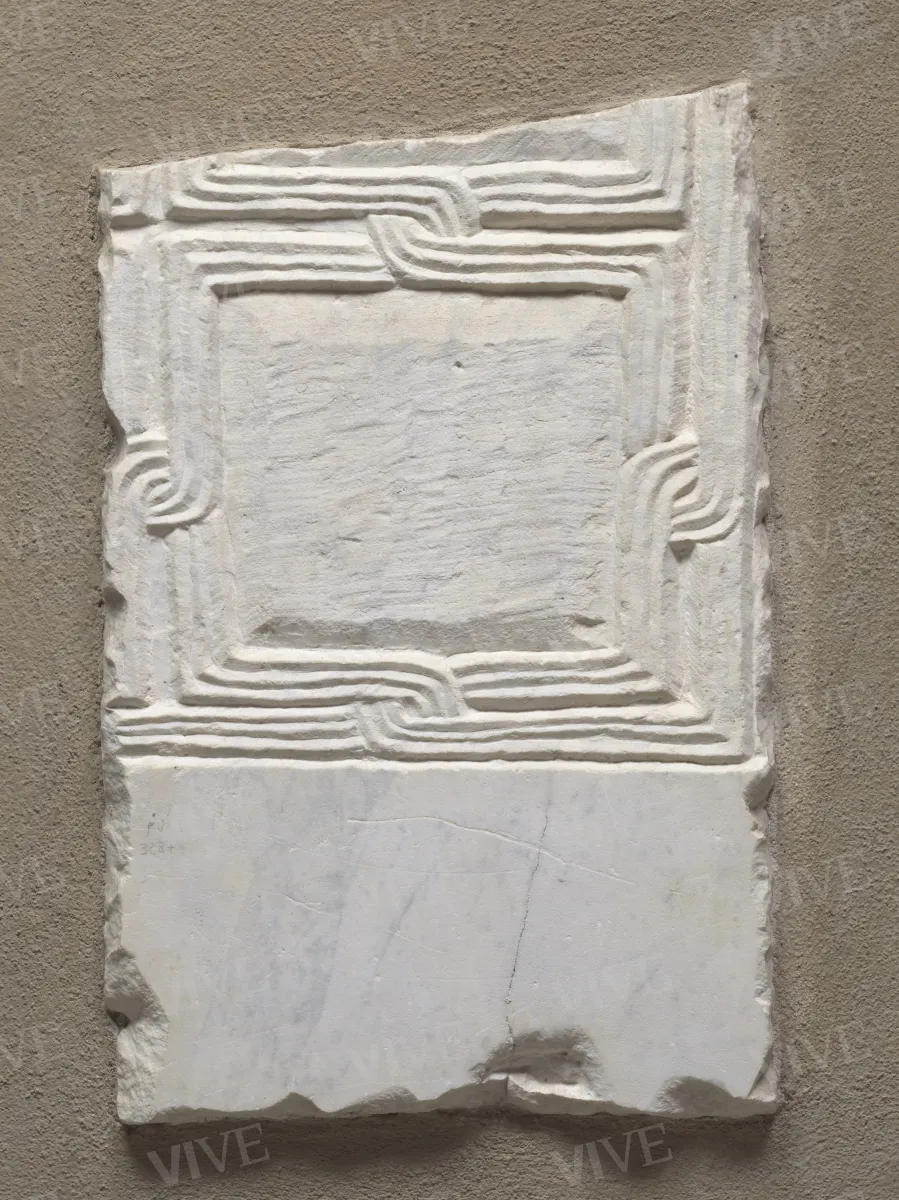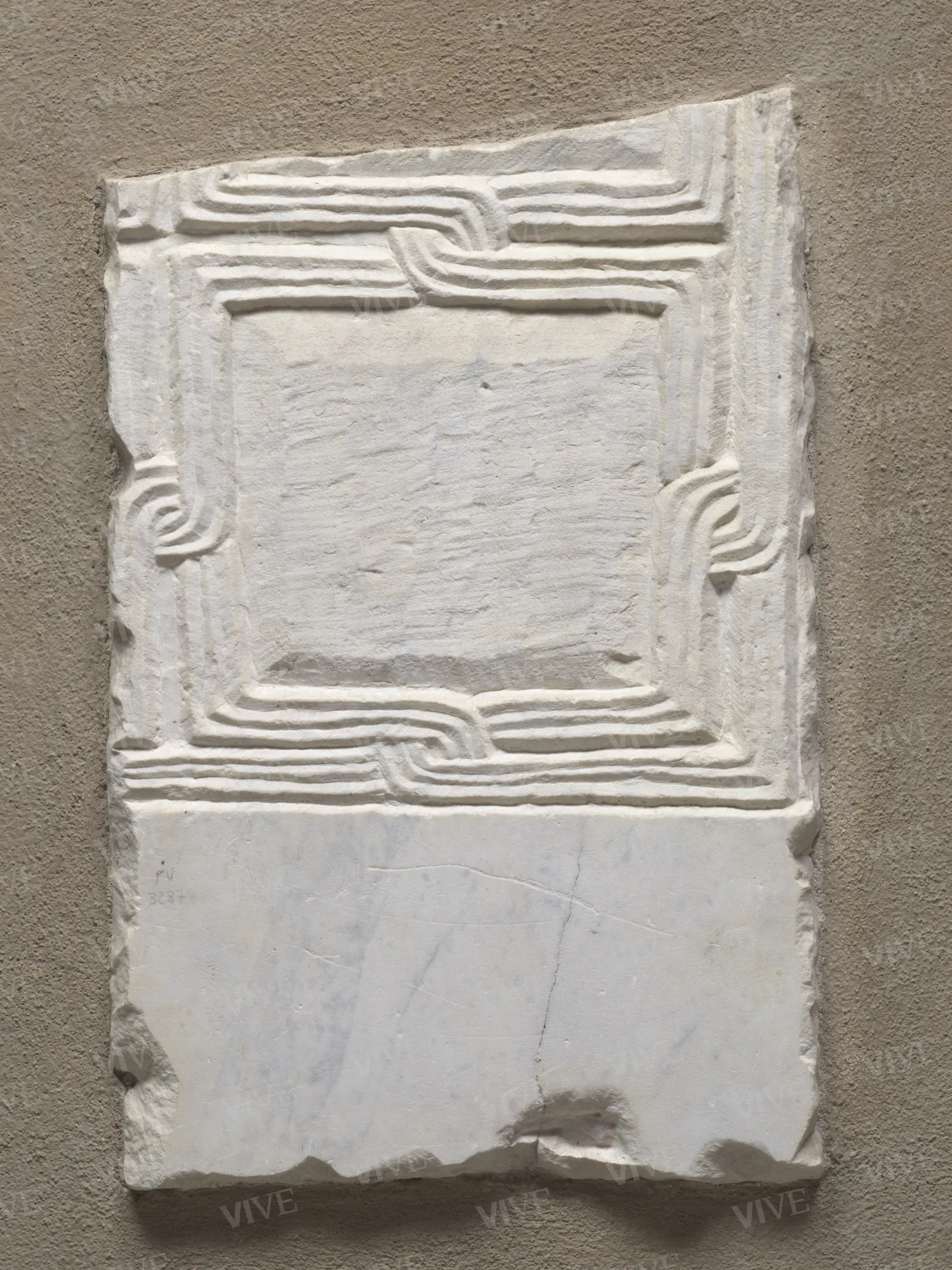Fragment of a square-mesh marble slab
Roman milieu 9th century
Fragment of a marble slab decorated with a network of square meshes of knotted two-lined wicker ribbon with an unworked emergent central square.
Fragment of a marble slab decorated with a network of square meshes of knotted two-lined wicker ribbon with an unworked emergent central square.
Details of work
Catalog entry
The marble slab fragment is unfinished, and the central square emerges only sparingly from the marble ground. The ornamentation, characterized by a typically Roman Carolingian motif from the first half of the ninth century with filled square meshes of knotted two-lined wicker ribbons (Kautzsch 1939; Macchiarella 1976), is devoid of a central iconic design, which the numerous Roman and Latium field attestations in the Spoleto Corpus of early medieval sculpture suggest might have been made of heart-shaped leaves, lilies, crosses with patented arms, stylized palmettes or saplings, Gordian knots, and interwoven skeins. The absence of these motif elements, moreover, can be evinced thanks to the obvious asymmetry between the unworked surface of the only complete quadrilateral and the vertices of the bisected wicker ribbon and the plain frame. The central space of the box, proud of the marble ground after the completion of the interlaced ribbon frame design, would normally have been given a final important, symbolically significant iconic motif by the artisans.
Another example of unfinished decoration can be found in the marble slab with crosses inscribed in intersecting squares forming an eight-pointed star, which is preserved and walled up in the hallway of Palazzo Nardini—or Palazzo del Governo Vecchio—in Rome (Flaminio 2018).
The tightly interwoven net and knots with sharp edges are the only elements that might afford us a dating context, as it is comparable to the pluteus fragments in the Santi Quattro Coronati (Melucco Vaccaro 1974, figs. 163 and 166), which can safely be dated to somewhere near the mid-ninth century.
The function of the slab, which came to Palazzo Venezia from excavations in the area of the Palazzetto in 1910–1914, cannot be deduced from the fragment as it is walled in—its thickness can therefore not be ascertained, and the verso is no longer visible. Formally, the carving appears somewhat uncertain, its grooves sometimes deeper and sometimes more superficial, with discontinuous lines that are sometimes crooked and imprecise.
Valentina Brancone
State of conservation
Mediocre. Cropped and chiseled with holes and other nicks.
Restorations and analyses
1999 (cleaning).
Provenance
Unknown. Found during excavations for the Palazzetto, as part of demolition carried out in the area for the relocation of the Palazzetto di Venezia (1910–1914).
Sources and documents
Rome, Archivio del Museo del Palazzo di Venezia, Bulletin, tome IV (handwritten annotation by Federico Hermanin, June 30, 1921);
Rome, Archivio del Museo del Palazzo di Venezia, list of marble fragments throughout Palazzo Venezia (manuscript inventory by Federico Hermanin, no year);
Rome, Archivio del Museo del Palazzo di Venezia, inventory of the sculptures in the lower and upper loggias (manuscript inventory edited by Maria Vittoria Brugnoli, 1973).
References
Kautzsch Rudolf, Die römische Schmuckkunst in Stein vom 6. bis zum 10 Jahrhundert, in «Römisches Jahrbuch für Kunstgeschichte», III, 1939, pp. 3-73;
Melucco Vaccaro Alessandra, La Diocesi di Roma, t. III, La II regione ecclesiastica, Corpus della scultura altomedievale, VII, Spoleto 1974;
Macchiarella Gianclaudio, Note sulla scultura in marmo a Roma tra VIII e IX secolo, in Istituto di Storia dell’Arte dell’Università di Roma (a cura di), Roma e l’età carolingia. Atti delle giornate di studio (Roma, 3-8 maggio 1976), Roma 1976, pp. 289-299;
Latini Massimo, Sculture altomedievali inedite del Museo Nazionale del Palazzo di Venezia in Roma, in «Rivista dell’Istituto Nazionale d’Archeologia e Storia dell’Arte», 57, 2003, pp. 113-152;
Latini Massimo, in Barberini Maria Giulia (a cura di), Tracce di pietra. La collezione dei marmi di Palazzo Venezia, Roma 2008, pp. 175-194, schede 1-29;
Flaminio Roberta, Sulle tracce di un bassorilievo poco conosciuto: la lastra con le croci di Palazzo Nardini al Governo Vecchio (Roma), in Pedone Silvia, Paribeni Andrea (a cura di), «Di Bisanzio dirai ciò che è passato, ciò che passa e che sarà». Scritti in onore di Alessandra Guiglia, t. I, Roma 2018, pp. 299-317.












